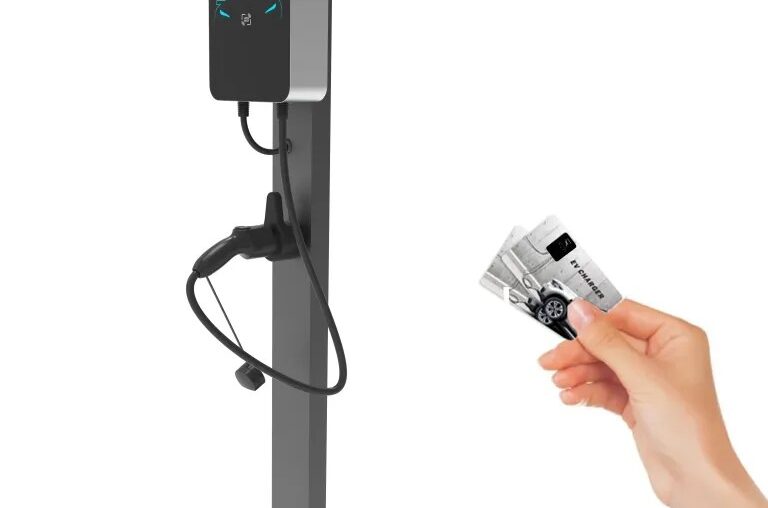Embracing Smart Charging: The Power of RFID in EV Infrastructure
As a leading EV charger manufacturer in China, LiCB Charge offers reliable AC and DC electric vehicle charging stations along with comprehensive charging solutions to meet your needs.
As electric vehicles (EVs) continue to gain popularity, the demand for efficient, easy-to-use charging stations is on the rise. Among the various technologies enhancing the EV charging experience, Radio Frequency Identification (RFID) has emerged as a standout solution, particularly in public and workplace charging environments. This article breaks down how RFID works in EV charging, its benefits, and why it has become a cornerstone of modern charging infrastructure.
What is RFID in EV Charging?
RFID stands for Radio Frequency Identification, a system that uses electromagnetic fields to identify and track objects via unique tags. In the context of EV charging, an RFID card acts as a key to initiate and manage charging sessions. By simply tapping the RFID card on a reader at the charging station, drivers can unlock the station, start charging, and even track usage and billing.
Think of it like tapping your credit card to make a purchase — but in this case, it’s to power up your EV.
RFID in Public and Private Charging Stations
-
Public Charging: RFID is primarily used at public EV charging stations, which can be found in:
-
Motorway service areas
-
Shopping malls
-
Public parking lots
-
Urban centers and office buildings
-
These stations offer varying charging speeds, from standard AC chargers (7 kW) to fast DC chargers (50 kW and beyond), and RFID ensures drivers can access them effortlessly.
-
Private and Workplace Charging: While less common, RFID is also used in private settings like home charging stations or at workplaces. Employers or fleet operators may distribute RFID cards to manage access, monitor energy consumption, and allocate costs for company vehicles.
Why RFID is Essential for EV Charging
-
Convenience & Speed: RFID cards streamline the charging process. No need for apps or internet connectivity—just tap and charge. It’s especially helpful in areas with weak signals or during colder weather when touchscreens can be unresponsive.
-
Security: Each RFID card is linked to a unique user account, preventing unauthorized access. Since there’s no physical contact with the reader, RFID systems are also resistant to wear and tear.
-
Compatibility Across Networks: Many RFID cards are compatible with multiple charging networks, allowing drivers to access a wide range of stations with a single card. This roaming feature makes charging more flexible, as it eliminates the need to manage multiple accounts or apps.
-
Cost Transparency: RFID technology helps track energy usage, ensuring transparent billing. Users can easily monitor their charges, making it ideal for both individual drivers and businesses managing fleets.
How Does RFID Work in EV Charging?
The process of using RFID at a charging station is simple:
-
Tap your RFID card on the reader.
-
The system authenticates your account and starts the charging session.
-
After charging, tap the card again to stop the session.
-
Usage and billing details are tracked for review, either through an online dashboard or app.
Advantages of RFID in EV Charging
-
User-Friendly: RFID cards make accessing charging stations hassle-free.
-
Reliable: No physical contact means longer-lasting cards and reduced maintenance.
-
Wide Reach: Interoperability across various charging networks gives users access to many stations with a single RFID card.
-
Secure: Each card is tied to a unique account, offering enhanced security and access control, especially in shared or commercial spaces.
RFID Frequencies in EV Charging
RFID operates on different frequency bands:
-
Low Frequency (LF): Used in access control, typically at 125 or 134.2 kHz, offering shorter ranges.
-
High Frequency (HF): The most common for EV charging, operating at 13.56 MHz. It’s reliable, fast, and secure, compatible with global standards like ISO/IEC 14443.
-
Ultra-High Frequency (UHF): Used in logistics but less common in charging.
-
Microwave Frequency: Offers fast read speeds but is not widely used in EV charging.
Challenges with RFID in EV Charging
While RFID has many benefits, there are some drawbacks:
-
Limited Network Coverage: Not all charging networks use RFID, with some relying on mobile apps or QR codes instead.
-
Card Compatibility: RFID cards may not work on all networks, especially if roaming agreements aren’t in place.
-
Lost Cards: If an RFID card is lost or stolen, there’s a risk of misuse, though many services allow for quick deactivation.
The Future of RFID in EV Charging
While new technologies like Plug & Charge (ISO 15118) and mobile wallets are on the horizon, RFID is expected to remain a core part of the charging landscape. These newer solutions may complement RFID, but the simplicity, security, and reliability of RFID ensure it will remain essential, especially in areas with limited internet access or when quick access is needed.
Conclusion: RFID’s Role in the EV Revolution
RFID technology has become a vital part of the EV charging ecosystem, offering a fast, secure, and user-friendly experience for millions of drivers. Whether at public charging stations or for businesses managing EV fleets, RFID enables smooth and transparent charging, ensuring ease of access and cost control. While innovations like mobile wallets and biometric authentication are on the rise, RFID continues to be a trusted, dependable solution in the world of electric vehicle charging.Know more about Google SEO Directory



